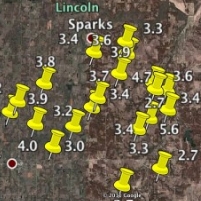Fracking Suspected in Rash of Earthquakes in Unlikely Places
Wednesday, December 14, 2011
 Earthquakes in Oklahoma (graphic: Kelley E. McDonald, administrator of Stop Fracking Oklahoma Facebook Page)
Earthquakes in Oklahoma (graphic: Kelley E. McDonald, administrator of Stop Fracking Oklahoma Facebook Page)
Ohio is not exactly earthquake country, and yet the area near Youngstown has been struck nine times in eight months by seismic activity.
Critics of hydraulic fracturing, or fracking, used to capture underground supplies of natural gas blame it for the shaking in such an unlikely area. The new, highly profitable fracking industry is largely unregulated.
Seismologists found most of the quakes’ epicenters coincided with the location of a 9,000-foot well near downtown Youngstown, into which went leftover liquids from fracking operations in Pennsylvania. “As the wastewater was injected into the well under pressure, the thinking went, some of it might have migrated into deeper rock formations, unclamping ancient faults and allowing the rock to slip,” wrote Henry Fountain in The New York Times.
The Environmental Protection Agency, which is supposed to regulate oil- and gas-related disposal wells, has not set any seismic requirements for the wells.
In Arkansas, state officials became so alarmed by a swarm of more than 700 earthquakes that in July they shut down one disposal well, while the operators of three others shut down voluntarily. Since then there has been a significant decrease in earthquakes.
Alarm has also been raised in Oklahoma, where a 5.6 earthquake, the state’s largest in history, struck 30 miles east of Oklahoma City on November 5. Oklahoma, a major location for hydraulic fracturing, experienced between 2 and 6 earthquakes a year between 1972 and 2008. In 2010 there were 1,047.
Some natural gas industry representatives and scientists say the link between unexpected seismic activity and fracking is unlikely.
Meanwhile, some in the federal government have called for more research on the potential impacts of the drilling process.
“Scientific research needs to be done to understand the data on fluid injections and volumes,” William Leith, senior science adviser for earthquake and geologic hazards at the U.S. Geological Survey (USGS), told the Times. The USGS is currently studying areas experiencing increased seismicity activity where fracking is also taking place.
-Noel Brinkerhoff, David Wallechinsky
Add Quakes to Rumblings Over Gas Rush (by Henry Fountain, New York Times)
Did Fracking Cause Oklahoma's Largest Recorded Earthquake? (by Charles Q. Choi, Scientific American)
Examination of Possibly Induced Seismicity from Hydraulic Fracturing in the Eola Field, Garvin County, Oklahoma (by Austin Holland, Oklahoma Geological Survey) (pdf)
Arkansas Suspends Drilling of Injection Wells after Earthquake Swarm (by David Wallechinsky and Noel Brinkerhoff, AllGov)
- Top Stories
- Unusual News
- Where is the Money Going?
- Controversies
- U.S. and the World
- Appointments and Resignations
- Latest News
- Trump to Stop Deportations If…
- Trump Denounces World Series
- What If China Invaded the United States?
- Donald Trump Has a Mental Health Problem and It Has a Name
- Trump Goes on Renaming Frenzy






Comments